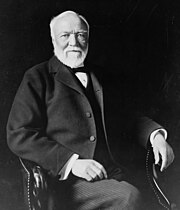Pre-history
1900年代,镀金时代的现代高峰期,一次世纪大战前,巨大财富集团的结合
文摘如下:
J.P. Morgan\'s acquisition of Carnegie Steel Company in 1901 represents arguably the first true modern buyout
Investors have been acquiring businesses and making minority investments in privately held companies since the dawn of the industrial revolution. Merchant bankers in London and Paris financed industrial concerns in the 1850s; most notably Credit Mobilier, founded in 1854 by Jacob and Isaac Pereire, who together with New York based Jay Cooke financed the United States Transcontinental Railroad.
Andrew Carnegie sold his steel company to J.P. Morgan in 1901 in arguably the first true modern buyout
Later, J. Pierpont Morgan\'s J.P. Morgan & Co. would finance railroads and other industrial companies throughout the United States. In certain respects, J. Pierpont Morgan\'s 1901 acquisition of Carnegie Steel Company from Andrew Carnegie and Henry Phipps for $480 million represents the first true major buyout as they are thought of today.
Due to structural restrictions imposed on American banks under the Glass-Steagall Act and other regulations in the 1930s, there was no private merchant banking industry in the United States, a situation that was quite exceptional in developed nations. As late as the 1980s, Lester Thurow, a noted economist, decried the inability of the financial regulation framework in the United States to support merchant banks. US investment banks were confined primarily to advisory businesses, handling mergers and acquisitions transactions and placements of equity and debt securities. Investment banks would later enter the space, however long after independent firms had become well established.
With few exceptions, private equity in the first half of the 20th century was the domain of wealthy individuals and families. The Vanderbilts, Whitneys, Rockefellers and Warburgs were notable investors in private companies in the first half of the century. In 1938, Laurance S. Rockefeller helped finance the creation of both Eastern Air Lines and Douglas Aircraft and the Rockefeller family had vast holdings in a variety of companies. Eric M. Warburg founded E.M. Warburg & Co. in 1938, which would ultimately become Warburg Pincus, with investments in both leveraged buyouts and venture capital.


[edit] Origins of modern private equity
It was not until after World War II that what is considered today to be true private equity investments began to emerge marked by the founding of the first two venture capital firms in 1946: American Research and Development Corporation. (ARDC) and J.H. Whitney & Company.[1]

ARDC was founded by Georges Doriot, the father of venture capitalism[2] (former dean of Harvard Business School), with Ralph Flanders and Karl Compton (former president of MIT), to encourage private sector investments in businesses run by soldiers who were returning from World War II. ARDC\'s significance was primarily that it was the first institutional private equity investment firm that raised capital from sources other than wealthy families although it had several notable investment successes as well.[3] ARDC is credited with the first major venture capital success story when its 1957 investment of $70,000 in Digital Equipment Corporation (DEC) would be valued at over $355 million after the company\'s initial public offering in 1968 (representing a return of over 500 times on its investment and an annualized rate of return of 101%).[4] Former employees of ARDC went on to found several prominent venture capital firms including Greylock Partners (founded in 1965 by Charlie Waite and Bill Elfers) and Morgan, Holland Ventures, the predecessor of Flagship Ventures (founded in 1982 by James Morgan).[5] ARDC continued investing until 1971 with the retirement of Doriot. In 1972, Doriot merged ARDC with Textron after having invested in over 150 companies.
J.H. Whitney & Company was founded by John Hay Whitney and his partner Benno Schmidt. Whitney had been investing since the 1930s, founding Pioneer Pictures in 1933 and acquiring a 15% interest in Technicolor Corporation with his cousin Cornelius Vanderbilt Whitney. By far, Whitney\'s most famous investment was in Florida Foods Corporation. The company, having developed an innovative method for delivering nutrition to American soldiers, later came to be known as Minute Maid orange juice and was sold to The Coca-Cola Company in 1960. J.H. Whitney & Company continues to make investments in leveraged buyout transactions and raised $750 million for its sixth institutional private equity fund in 2005.
Before World War II, venture capital investments (originally known as development capital) were primarily the domain of wealthy individuals and families. One of the first steps toward a professionally-managed venture capital industry was the passage of the Small Business Investment Act of 1958. The 1958 Act officially allowed the U.S. Small Business Administration (SBA) to license private Small Business Investment Companies (SBICs) to help the financing and management of the small entrepreneurial businesses in the United States. Passage of the Act addressed concerns raised in a Federal Reserve Board report to Congress that concluded that a major gap existed in the capital markets for long-term funding for growth-oriented small businesses. Additionally, it was thought that fostering entrepreneurial companies would spur technological advances to compete against the Soviet Union. Facilitating the flow of capital through the economy up to the pioneering small concerns in order to stimulate the U.S. economy was and still is the main goal of the SBIC program today.[6] The 1958 Act provided venture capital firms structured either as SBICs or Minority Enterprise Small Business Investment Companies (MESBICs) access to federal funds which could be leveraged at a ratio of up to 4:1 against privately raised investment funds. The success of the Small Business Administration\'s efforts are viewed primarily in terms of the pool of professional private equity investors that the program developed as the rigid regulatory limitations imposed by the program minimized the role of SBICs. In 2005, the SBA significantly reduced its SBIC program, though SBICs continue to make private equity investments.
网上来源:Wikipedia:early history of private equity